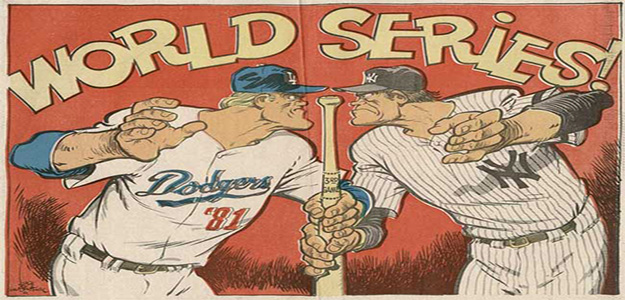Though the Cincinnati Reds and St. Louis Cardinals got cheated in 1981 (see “1981 Cincinnati Reds Blog”) due to the provisional playoff structure, those captaining the ship positioned the vessel right where they wanted. When baseball’s longest postseason to date reached its final event, the Los Angeles Dodgers and New York Yankees were the last two teams standing. An iconic pair of marquee franchises squaring off on center stage, the 1981 World Series marked the eleventh time in history that the two would meet for the Fall Classic. On average, around 41 million viewers tuned into each game on their television sets to watch the Series unfold, which, according to Baseball Almanac, is the third-most viewers per championship contest since 1973 (“World Series Television Ratings”). In the past, the championship clashes between the two renowned rivals had given the world fantastical events that will live on forever in baseball history.
In their first meeting, the 1941 World Series, Dodgers catcher Mickey Owen infamously gave the franchise a lowlight moment when he was unable to handle a pitch thrown by Hugh Casey. In Game 4, with two outs in the ninth and the Dodgers up by one, Casey got the Yankees’ Tommy Henrich to swing and miss at a nasty off-speed pitch in the dirt. Tragically, the ball went behind Owen, which allowed Henrich to reach first on a passed ball, prolonging the inning. The Yankees went on to score four runs before Brooklyn could get the final out and won the game, 7-4, increasing their series lead, three games to one. In a series that should have been tied at two apiece, Owen’s blunder was the nail in the coffin, as the Yankees won it all in five. “That was a tough break for poor Mickey to get,” said Tommy Henrich, expressing his remorse following the Yankees’ shocking Game 4 victory thanks to the series-shifting mishap. “I bet he feels like a nickel’s worth of dog meat” (qtd. in Smith 45).
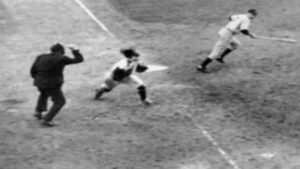
In 1947, one year after the nation saw Bugs Bunny take over for the lousy, long-in-the-tooth Tea Totallers baseball team in the middle of a ballgame and perform the impossible by single-handedly overcoming a massive deficit en route to defeating the mighty Gas-House Gorillas in the popular cartoon Baseball Bugs, the world witnessed another shocker on the ballfield. As opposed to presenting itself in an animated short via a talking rabbit—though Bugs’ ability to fire his fastball with high velocity, mix up his speed with his patented “Bugs Bunny change-up,” play all nine positions, and plate an unfathomable amount of runs with his swing was much appreciated—this referenced event came in real life on the biggest stage.
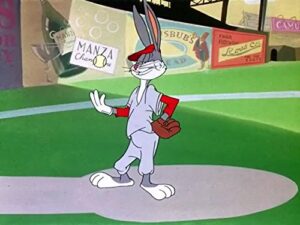
In the 1947 Series, baseball followers observed Joe DiMaggio express tangible frustration, which, for anyone familiar with “The Yankee Clipper,” was a rarity. This came in the bottom of the sixth in Game 6 when DiMaggio crushed a ball to deep left-center that, had it left the park, would have resulted in a game-tying three-run homer. The problem was, Brooklyn’s Al Gionfriddo, who entered the game as a defensive replacement, robbed DiMaggio at the 415-foot marker to end the inning. Had Gionfriddo missed, the ball would have dropped right into the Brooklyn bullpen. The second DiMaggio realized Gionfriddo had spoiled his perfectly timed swing, the Yankees legend kicked up some dirt in dismay while rounding the bases. Upon getting to his position in centerfield to start the next inning, DiMaggio, with his back to home plate, punched his glove and gave the grass a few rough kicks to further show his disappointment. A known-to-be taciturn hero in public, who played the game with honor and dignity, it was in this moment that the strong-minded DiMaggio appeared human—something that, because of the nature of his character, mixed with his outlandish output in the beloved sport, had been perceived to be out of the cards.
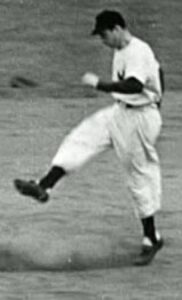
New York would score just one more run in the game, and the Dodgers forced Game 7. Bill Terry, former manager of the New York Giants, when speaking on Gionfriddo’s game-saving, season-preserving play, said it was “the greatest catch I have ever seen” (qtd. in Jones 72). The consensus in the Yankees’ locker room after the heartbreaking loss was that their star centerfielder had never hit a ball harder in his life than that shot in the sixth. When asked while seated at a table in the center of their locker room if that was, in fact, the hardest ball he had ever hit, DiMaggio just sat there in silence. Fortunately for Joltin’ Joe and his counterparts, New York wound up winning the for-all-the-marbles Game 7.
The result remained the same in their matchups in 1952 and 1953, thanks to the power-hitting successor to Joe DiMaggio, Mickey Mantle, who slugged two home runs in the 1952 series and two more in 1953. When speaking on his team’s sour end to their 1952 campaign, Brooklyn star Jackie Robinson was quoted after the series saying, “It was that Mantle, that Mickey Mantle killed us.” Going on to mention that, “If it hadn’t been for him, I think this would have been a very different series” (qtd. in Brown 19). The 21-year-old switch-hitting Mantle, whose pair of homers served as the winning runs in the final two games of the series, had this to say following the championship-clinching game: “Winning this series was a greater thrill than my homers and even that grand-slammer of mine against the White Sox during the regular season (a go-ahead bases-clearing home run in the top of the ninth at Comiskey Park). I felt tight out there at the start, but it will be nice to go home now and work in the mines” (qtd. in Brown 20). When the reporter questioned why the star ballplayer felt the need to work in the mines of Oklahoma in the immediate offseason, The Commerce Comet answered, “I’ve got to earn some money. You know I’ve got seven dependents back home and they’re counting on me” (qtd. in Brown 20).
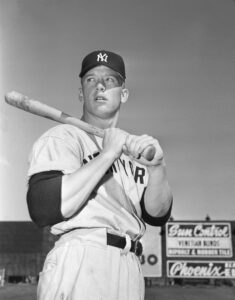
Brooklyn was finally able to turn the tide around in 1955. Robinson stole home, a swipe that resides as the last successful straight steal of home in a World Series game. Years later, in 1966, during the animated television special titled Charlie Brown’s All Stars!, the gentle-hearted Charlie Brown attempted to perform his best impression of Jackie by trying to steal home in a big game, but the “blockhead” was unsuccessful in his bid. Alongside Robinson, Duke Snider clubbed four dingers, Johnny Podres pitched a pair of complete games, and the franchise earned its first-ever championship. A year later, the two met for the sixth time in the series, a Fall Classic highlighted by the Yankees’ Don Larsen, who pitched a perfect game in Game 5—a historic feat that, to this day, resides as the only perfect game in World Series history. On the offensive side, “The Mick” clobbered a trio of home runs. He would finish his career with 18 World Series home runs, which still stands as the record for most homers in the final championship round.
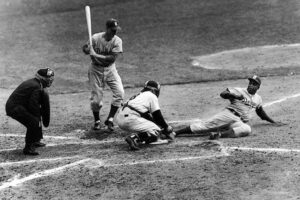
They would then meet again in 1963, where star pitchers for the now “Los Angeles” Dodgers, Sandy Koufax and Don Drysdale, proved to be too much for the aging Yankee lineup. In Game 1, Koufax, the eventual World Series MVP, pitched a complete game with an astounding 15 strikeouts, which was the record for most punch-outs by a pitcher in the series until Bob Gibson eclipsed it with 17 in 1968. “You can sum up the entire game in one word: Koufax,” said Yankees manager Ralph Houk following the record-breaking performance. “He was great all the way. There’s nothing you can do when a man pitches a game like that against you” (qtd. in Miller 33).
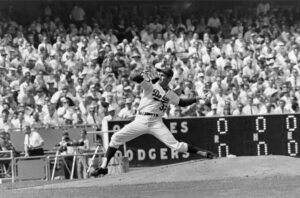
Fourteen years later, with new stars featured across both lineups, the two squared off once again in 1977. It was in this series where Yankees slugger Reggie Jackson garnered the moniker “Mr. October” for his monumental production. In total, Jackson hit five home runs in the series, with three of them coming, in consecutive at-bats, in the series-clinching win. He was the first player to ever hit five in a single World Series, a mark that still keeps him atop the record books, though he is now joined by Chase Utley (2009) and George Springer (2017), who have since accomplished the feat. At the time of his three-homer night in the Fall Classic, he joined Babe Ruth (1926, 1928) as the lone ballplayers to hit three in one game. However, as time went on, The Babe and Reggie would be accompanied by Albert Pujols (2011) and Pablo Sandoval (2012). En route to winning the 1977 World Series MVP, Jackson had 25 total bases and 10 runs scored, which, in the moment, stood as Series records, though, like many records, both were eventually broken. “I have never seen anything like that in a championship game situation,” said Dodgers first baseman Steve Garvey, in reference to Jackson’s historic three-homer night. “He beat us singlehandedly. And actually that’s exactly what he did. He knocked in five runs (a pair of two-run home runs and one solo shot) and we only scored four” (qtd. in Davis 58). Garvey’s coach, the legendary Tommy Lasorda, said that Jackson put on “the greatest performance that I’ve ever seen in a World Series” (qtd. in Davis 59).
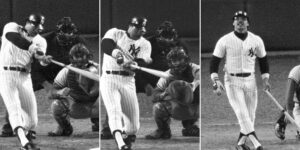
The two would match up again the following year in 1978, a carbon copy of the 1977 series, as the Yankees won in six. This time around, Jackson was held to just two home runs. So when 1981 came around, millions of fans watched in anticipation for the next big moment, as it felt like every time these two met to crown a champion, stars were born, and epic events played out left and right. Through the first ten World Series bouts, the Yankees held a commanding lead over the Dodgers, winning eight of them. However, in 1981, good fortune was on the side of the City of Angels. Dodgers pitcher Fernando Valenzuela, the aforementioned Cy Young Award winner, capped off his historic freshman season in the bigs with a complete-game victory in Game 3 of the series. Down 2-0 heading into the contest, Los Angeles turned to their 20-year-old efflorescing star in a must-win scenario, as no team in World Series history has ever flipped the script and won it all after dropping the first three games.
Though Valenzuela did not have his best stuff, as he wound up walking seven, which was the most free passes he had given up all year, while also surrendering two home runs after not giving up any in his previous 13 starts, the folk hero from Mexico got the job done. In total, Valenzuela threw 145 pitches, fanned six, and got clutch outs when he needed to. After allowing four runs in the first three innings, Valenzuela blanked the Yankees the rest of the game. It was not pretty, but his gutsy performance kept the Dodgers alive. “He did not have his best stuff,” said Valenzuela’s coach, Tommy Lasorda, after the NL Rookie of the Year battled through his inability to control his pitches. “But it was one of the guttiest performances for a pitcher without his stuff that I’ve seen in a young man. He was like a poker player bluffing his way through a bad hand. And when he smelled the win, he went after it. There were a couple times when I contemplated taking him out but thank God we didn’t. I left him in because I firmly believe that this is the year of Fernando” (qtd. in Garcia 27).
Valenzuela’s courageous performance proved to be the exact spark that the Dodgers needed. After getting on the board in Game 3, Los Angeles did not look back and won the next three ballgames on the way to capturing their fifth World Series title in franchise history. For the first time ever, three players shared the World Series MVP: Ron Cey, Pedro Guerrero, and Steve Yeager. A fun fact about Steve Yeager: following his retirement from the sport in 1986, the Dodgers backstop continued to contribute to the game by helping train actor Tom Berenger for his role as a washed-up catcher in the 1989 film Major League.
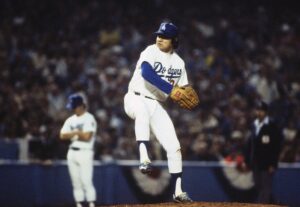
Though both organizations have since endured a more-than-healthy amount of success, prior to their most-recent bout in 2024, their battle in 1981 was the last time that the pair had clashed head-on with a championship on the line.
Works Cited
Brown, David. “Mantle’s Heroics Seal 1952 Series.” New York Post, 15 Oct. 1952, pp. 19-20.
Davis, John. “Reggie Jackson’s October Legacy.” Los Angeles Times, 20 Oct. 1977, pp. 58-59.
Garcia, Maria. “Valenzuela’s Grit Keeps Dodgers Alive.” Los Angeles Herald, 24 Oct. 1981, p. 27.
Jones, Robert. “Gionfriddo’s Catch Stuns Yankees.” Brooklyn Eagle, 6 Oct. 1947, p. 72.
Miller, James. “Koufax Dominates in Game 1.” New York Times, 3 Oct. 1963, p. 33.
Smith, Thomas. “Henrich Reflects on Owen’s Error.” New York Daily News, 12 Oct. 1941, p. 45.
“World Series Television Ratings.” Baseball Almanac, www.baseball-almanac.com/ws/wstv.shtml. Accessed 21 Mar. 2025.

